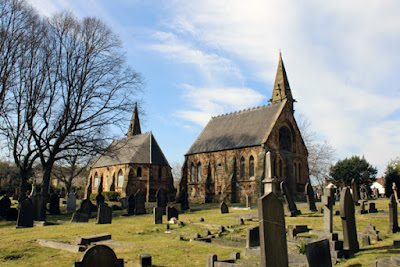 |
| A gargoyle at Masbrough Cemetery |
Finally arriving at High Street in Kimberworth from Little Common Lane, having explored some of the local geology at Thundercliffe Grange, Ockley Bottom and Grange Moor Quarry, there is not much to suggest that the village - now just a suburb of Rotherham – has ancient origins.
Listed as Chiberworde in Domesday Book, Kimberworth formed part of the manor of Roger de Busli and possessed a motte and bailey castle, the remains of which are now hidden behind a housing estate, but it was not recorded as having a church.
Continuing down towards Church Street, I caught a glimpse of the farm buildings at Old Hall Farm, which date back to the mid C18 and, on the opposite side of High Street and on Peter Street – where I lived for a year - there is a small group of Victorian terraced houses.
On my walk so far, I had crossed very many of the various strata that are depicted on the British Geological Survey Sheet 87 map, including the Silkstone Rock (SR) and the Parkgate Rock (PR) – which I had recently encountered when briefly surveying various Grade II Listed buildings around City Road and Norfolk Park Road in Sheffield.
As with the sandstone used for these buildings in Sheffield, without documentary evidence to back up my observations, I can again only make a guess at the provenance of the building stones used in Kimberworth – especially since it is only the very distinctive Rotherham Red sandstone that has gained any reputation as a building stone in the area.
Making my way down Church Street, I only took a few photographs of St. Thomas’ church for the British Listed Buildings website but I did notice that the sandstone used in the tower is rich in iron, with the Liesegang rings being differentially weathered.
A little further down Church Street, the unlisted Manor Barn public house is built in a very similar sandstone, as is the late C17 Kimberworth Manor House to the rear of it – which is the most interesting historic building in the village. Sadly, two other Grade II Listed buildings in its grounds - a dovecote and an old barn - have been sadly neglected.
After the latest COVID-19 Pandemic lockdown, the beer garden was full of people enjoying the mid April sunshine and, after taking advantage of the good weather to enjoy a pint of cold lager shandy myself, I continued down Kimberworth Road to Masbrough Cemetery.
I know very little about the cemetery, except that it was opened in 1868, but the pair of unlisted chapels caught my eye, not least for the orange rock-faced Carboniferous sandstone, which I hadn’t encountered before or have seen since.
Although the development of a patina and algal growth on large sections of the masonry obscures its original colour, in conjunction with Rotherham Red sandstone and another massive sandstone used for dressings and ashlar, the chapels have been designed with a polychrome effect – a pattern repeated in the lodge at the entrance to the cemetery.
I would like to know who is the architect responsible for their design, because the chapels with tall ornamented towers, complete with gargoyles and winged grotesques, remind me of the American Gothic Revival style houses that often feature in old horror movies.











No comments:
Post a Comment